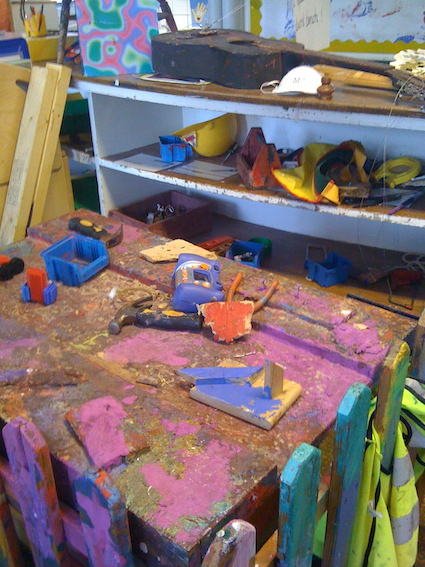
Several years ago, Sarah Lazarovic created the wonderful illustration, the Buyerarchy of Needs. It has always resonated with me, because I am aware of how resources dominate many educators’ thinking.
There has been a trend towards removing plastic resources and replacing these with natural equivalents. Whilst this may be a good long term objective, it immediately falls flat on its face as part of a sustainable approach, if the resources that are being thrown out end up in the dump, contributing to landfill. Instead move forward by considering how you acquire resources and why, rather than focusing purely on the material it’s made from.
In the spirit of the Buyerarchy of Needs, here’s some things to consider when managing resource provision outside:
1. Reflect upon your setting’s approach. A good video to watch to get everyone talking is the Story of Stuff.
2. Use what you have. Become a raider of the lost cupboard. Find out what exists that you have forgotten about. Do this with children rather than at the end of the day or on an in-set. Model a thoughtful approach to the management of the resources. Find out what they want to play with and use, outside or in.
3. Fix what is broken. Again, this is something that can be done with children. What is needed to fix something? Is it a bit of duck tape? A screw driver to tighten a loose screw? Sandpaper to smooth a rough edge? If you don’t know how to fix something, ask the children for ideas. They may suggest looking at an online video. They may have a parent who can advise. You may have a janitor that can show you how to undertake minor repairs. The children then learn how to fix things, who can help and in doing so, develop a greater understanding of community.
4. Create a “taking apart” table or station. This is an area, inside and out, where things can be taken apart and investigated by children. It is a good way to learn about how things work, how things are put together, what components are used in the creating of resources. It is a great complement to a woodworking area or maker space, because you will build up a supply of parts that can be used in other creations. You will need to consider what tools are suitable for children to access independently and which need adult supervision. You will also need to put in place sensible safety precautions and checks.
5. Borrow resources. Many years ago, as a headteacher of a tiny Highland school, I teamed up with other local small schools to create shared resource boxes. We realised we couldn’t afford to resource an entire curriculum and that a lot of materials may lie in boxes for a long time before being used so this made economic, social and environmental sense. I also signed the school up to membership of the toy library. Once a month, the toy library would visit and the children could borrow resources.
6. Set up a Swap Shop or Giveaway Day. This can be for your local families as well as for nearby nurseries and schools. Have the resources you no longer use made available for others to browse and use. If you are part of a large school or early years establishment, then ask your Parent Council to get involved. It could end up being a Bring and Buy Sale.
7. Donate good quality resources to charity organisations. There are many places that need resources: Women’s Aid shelters, toy libraries, homeless charities. Create a positive relationship with a local charity shop.
8. Use online and social media support systems. As well as Ebay, Gumtree and Freecycle, there are now many Facebook groups set up so that resources can be exchanged or sold or given away.
9. Repurpose resources. There are now oodles of online ideas for doing this. For example, checkout this blog post about re-using pallets and this one about making old books into seed packets. Old books can also be made into bunting, paper chains, background wall displays and so on.
10. Ask for donations. When you are developing your provision, develop your community support networks. Local businesses, families and other organisations are often willing to provide all sorts of materials. A polite, direct approach including letters and drawings from children can go a long way. Likewise, remembering to thank everyone personally and directly makes a big difference. Look for public ways of saying thank you too. With parents, it can help to make specific requests at different times of the year. For example, just before Christmas, ask for old Christmas trees and put up reminder notices for the first day back, as well as notices on social media.
Finally, remember to check your establishments auditing systems prior to getting rid of unwanted items. With some local authorities and schools, there are tight disposal protocols in place and you need to ensure that you follow these. Likewise, some establishments have inventories and resources that are being passed on, may required to be signed off.

This blog post was first published in December 2018.



















